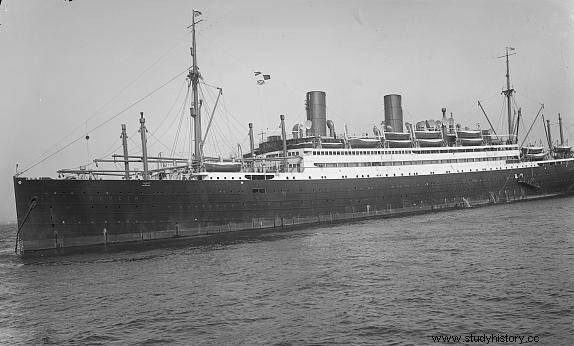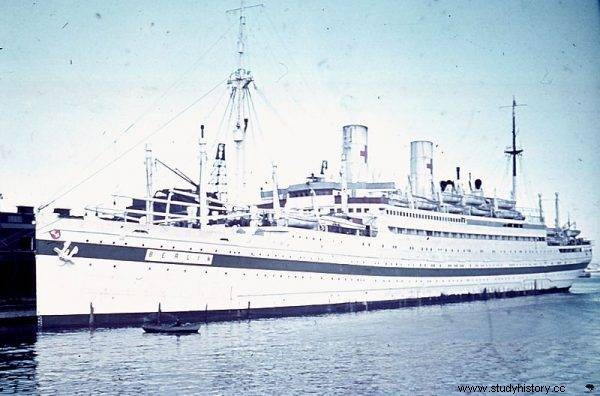The sinking of the Soviet cruise ship "Admiral Nakhimov" can be compared to the tragic voyage of the "Titanic". Certainly, this is not how the passengers imagined a fabulous holiday on the waves. The crash site looked macabre:hundreds of dead bodies swayed on the surface of the water.
On August 31, 1986 at At 23:20 Moscow time, "Admiral Nakhimov" collided with a large bulk carrier "Piotr Wasiow" and sank. There were 1,234 people on board at that time. Officially, there were 423 casualties, but in the Soviet Union the true dimension of many disasters was concealed, so this number could have been much greater.
It was all the more shocking that for the passengers of "Admiral Nakhimov" this cruise was supposed to be the crowning achievement of the holidays and a pleasant trip before the start of the school year and the return to work ...
Pedigree of "Admiral Nachimow"
The imposing cruise liner was considered to be a very high-quality vessel. Interestingly, it was not really a Soviet ship, but ... a German one, and in addition served its own during World War II. Built in 1925 in Bremen, it initially actually took passengers on fabulous cruises (then it was called "Berlin"), but after the outbreak of the global conflict, it was transformed into a hospital ship. It had room for 400 patients and 165 crew and medical personnel on board.
At the beginning of 1945, he was to take part in the great evacuation of soldiers and civilians from Prussia, Courland and the Bay of Gdańsk. Unfortunately, on January 31, just before the mission, he hit a mine. It was by no means the end of his troubles. While being towed to Kiel, it crashed into another mine and sank.
In 1949, the Russians pulled it out of the water, dried it and renovated it. In 1957 - after it was renamed "Admiral Nakhimov" - the ship started to function as a cruise ship again. He ran, among others on the Odessa-Batumi route and enjoyed great popularity because it had luxurious (for the USSR) conditions. In addition, during longer stops in ports, the crew organized sea trips for volunteers. Many newlyweds spent their honeymoon there.
August 31, 1986
August 31 at At 22:00 "Admiral Nakhimov" left the port in Novorossiysk and set off towards Sochi. The command knew that near the port, the ship would pass the bulk carrier "Piotr Wasiow". At. At 23:00 the cruise ship crew asked their colleagues from "Wasiów" to let them pass by radio, arguing that they had 1000 passengers on board. She received permission, so the captain of the "Nakhimov", Vadim Markov, left the captain's bridge, although he should remain there until the end of the maneuver.

Before it fell into Russian hands, the cruise liner - as "Berlin" - was a German unit.
Soon the first officer, Aleksander Czudnowski, noticed that the distance between the ships was dangerously shortening and alerted the crew of the bulk carrier. The captain of "Wasiv", Viktor Tkachenko, reassured him: "There is no fear. We will walk cleanly. We are in control of the situation. " However, the bulk carrier neither decreased speed nor changed course. Czudnowski repeatedly alerted Tkaczenka, shouting:"What are you doing ?! We're gonna collide right now! ”. But this one did not remain unmoved because - as witnesses said - he completely trusted the navigation equipment.
“Tkachenko knew electronics, he was very interested in technological achievements. He trusted the instruments completely. But computers are programmed by people who can make mistakes, which was proved by the collision of two ships, "said Valery Timoshenko, who reported the tragedy as a correspondent for the regional youth newspaper.
At. At 23:10 a sailor ran onto the "Piotr Wasiów" captain's bridge and shouted that they would collide with the "passenger" (passenger ship) in a moment. Then even Tkachenko doubted. When he heard Czudnowski scream:"What are you doing ?!", he ordered:"Back all the way!" But it was too late - at There was a collision on 23/12.
8 minutes… and it's over
"Piotr Wasiow" literally rammed "Admiral Nakhimov". Experts determined that the area of the hole in the cruise ship's hull was 84 square meters. The passengers, who were on the right deck at the moment of the impact, felt two strong shocks. Several dozen seconds later, the power plant was flooded with water. The lights went out and radio communication was lost. The ship was no longer steerable.
At the time of the collision, the children were already asleep, and the adults were watching the concert on the upper deck. To save the little passengers, crew member Wiera Fiedorczuk took spare keys. She intended to open the cabins and allow the little ones to escape, but she herself died before she could help them.

During World War II, "Berlin", or later "Nakhimov", served as a hospital ship.
Captain Markov ordered the sailors to sound the alarm, prepare lifeboats and rafts. However, the water filled the ship with alarming speed, so the crew only managed to launch one lifeboat. Admiral Nakhimov sank just 8 minutes after the impact. There were hundreds of its passengers in the sea. Markov was stuck on the captain's bridge until he was swept away by the wave. Aleksander Czudnowski decided to stay on the cruise ship forever - he locked himself in his cabin.
A large amount of fuel began to spill from the damaged tanks of Nakhimov into the sea. It soon formed a thick, oily film that restricted the movement of the survivors.
See also:The most spectacular plane crash in history. The Fall of Hindenburg
To the rescue
10 minutes after the sinking of "Admiral Nakhimov", the first rescue units appeared on the site of the tragedy (there were 64 of them in total). The crew of "Piotr Wasiów" also participated in the rescue operation.
According to official data, 359 passengers and 64 crew members were killed in the crash. It is not known whether these numbers are correct, because - first - the Soviet Union rarely revealed the truth about disasters. Secondly, on board the "Admiral Nakhimov" often "after acquaintances" came relatives and friends of sailors who were not entered in the registers. Third, some survivors only died days after the tragedy from drinking contaminated water.
In 1987, the trial of captains Markov and Tkachenko took place in Odessa. They were found guilty of the catastrophe and sentenced to 15 years' imprisonment. In 1992, they were pardoned by President Boris Yeltsin.
After his release, Markow returned to service in the navy, but was harassed by the relatives of the victims of the crash. Therefore, he had to change his name, place of work and residence. Tkachenko also experienced persecution and therefore emigrated to Israel. In September 2003, he died in an accident on a yacht he was managing.
